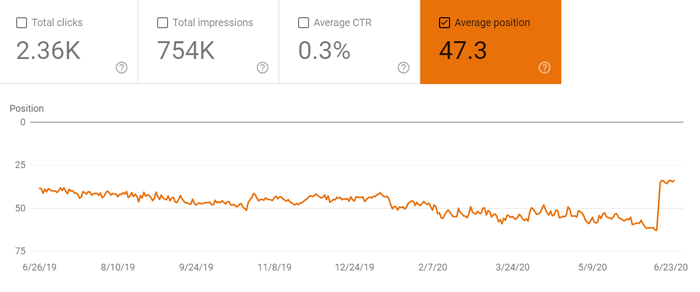
Old content is not just clutter that’s taking up space in your website. It can also be one of the main reasons you’re losing web traffic. It’s important to remember that content will need to be refreshed now and then as they get “stale” after just a few weeks, months or years.
Relevant and high-quality content is necessary to rank well on search engines. Otherwise, newer and more updated content from competitors will outrank your pages and diminish your online visibility.
Why Updating Old Articles is Good SEO Strategy
Every day, business owners, content marketers and content writers produce new blog posts and website copy. Many are about the same topics. So if you’ve written about the same subject matter as your competitor, except theirs is newer, your article is likely going to be overshadowed.
Here are some reasons to update, refresh or revamp old posts.

1. Content is Getting No Traffic
It’s a good move to update content if it serves no purpose to the website, especially if it gets little to no traffic at all. You can find an overview of your posts’ analytics in tools, such as Google Search Console or Google Analytics.
Identify content with potential to rank, or those that are relevant at the moment, and update them.
Another indication that your content is no longer relevant is when you’re getting a really low click-through rate (CTR).
2. To Avoid Cannibalization
Keyword cannibalization is one of the many issues that SEO specialists and content marketers tend to avoid. It refers to when a site has more than one piece of content that targets the same keyword.
When there’s keyword cannibalization, search engines could rank the page that is not a priority for your marketing goals.
For example, your product page is optimized for “organic dog food.” But so are some of your blog posts. If you have multiple pages targeting that keyword, you’re diluting your page authority and veering focus away from the product page you want to rank first.
Instead of one page ranking all the traffic and ranking high on search results for your target keyword, traffic and clicks will be divided into multiple pages. This could open up opportunities for your competitors to outrank you.
3. To Make the Content Better
Have you ever published content you’re not happy with, or that you know you could’ve written better? Have you ever put up content that didn’t go through proper editing procedures and that you forgot about the second it was published?
Poorly written content has a way of hurting your credibility and authority. If users or consumers don’t see your brand as credible, you can easily lose them and their trust.
So go back and edit what was done. Re-read, re-write and edit poor content and make it more interesting for your readers.
4. To Provide Current Information
Outdated content eventually becomes irrelevant. Users and consumers are always looking for the newest information, the latest news and accurate details. Old and outdated content will contain outdated information that doesn’t apply to modern needs.
5. To Clean Up or Add Links
Links are a huge part of SEO and one of the main ranking signals. Updating content will allow you to add necessary links to the page. This can range from internal links (these are pages from your own website) to external links (links from third-party websites).
It also gives you a chance to clean up dead links. When users click a link that leads to a page that no longer exists, it affects their experience. And negative user experience may harm your search rankings in the long run.
How to Update Old Content
How do you turn nonperforming, existing blog posts into money-making content?

1. Update Your Keywords
Use online tools like Spyfu, Google’s Keyword Planner, or Ahrefs to look for fresh keywords.
Inserting high-ranking keywords into your content helps increase your chances of ranking high in search results. Choosing the ones that are most relevant to your business can help boost conversions and sales.
There will be times when a page needs to target and rank for more than one keyword to help increase its traffic and click-through rate. In this case, updating keywords on that page is necessary.
Using the same example as earlier. Let’s say you have a page that’s supposed to rank for “organic dog food,” but it’s not getting the traffic you want. After conducting your keyword research, you find that the page can also rank for “best organic dog food” and “organic raw dog food.” Inserting these keywords will allow you to attract more traffic, particularly users who are looking for “raw” dog food or those who added “best” dog food in their search query.
2. Update Meta Description, Meta Tags, Title Tags and Alt Tags
Another quick and easy way to update content is to update your meta description, meta tags, title tags and alt tags. These elements will give your page the needed boost so that searchers can easily find it.
Here’s a quick recap on the following:
- Title tag. This is the title that’s displayed when a search engine lists your web page on the results. This will engage and hook users, so make sure that it’s straight to the point and catchy. Also, as one of the best practices, insert the target keyword on the title tag, this way, search engines can easily understand what the content of your page is all about and can easily match user queries to it.
- Meta description. This contains the summary of your content and is shown when a search engine displays your link on search results. Write clear and concise descriptions of your content. It should be under 160 characters because Google truncates to 155 to 160; it should also contain your target keyword and be clickable.
- Image alt tag. Search engines aren’t as capable of understanding images the way we do. Make your images search-friendly by adding alternative texts or alt texts. This is also a great way to effectively insert a keyword that you’re aiming to rank for as it will let search engines know that your content is indeed related to that particular topic.
3. Add Images or Any Visual Content
Blogs with images tend to get about 94 percent more visits than those that don’t have any visuals. Photos allow your readers to connect more with your article since humans are visual creatures and we tend to remember information quicker when there are images attached.
Add one or two relevant images to your article, or you can create an infographic if applicable. Blogs with images are not only engaging but easier to share on social media as well.
4. Include New Information
New information is always introduced in any market. If you’re in the marketing business, it’s especially crucial to refresh your content to ensure your recommendations are in keeping with the times.
Updated content allows your business to stay relevant and valuable to your market. Even the so-called “evergreen content” will require updates to continue providing value for your site visitors.
5. Delete or Combine Posts
You may come across some content that dates back from when you first started your website and realize you’ve written about that same topic a few more times. Merge those blogs into one, more optimized and powerful blog.
When you merge articles with similar keywords and topics, you:
-
Boost dwell time because longer posts tend to perform better, encouraging users to stay longer on the page;
-
Remove articles that may not be performing well on search, and
-
Rank the article for more keywords since it’s expanded its scope.
6. Build Inner Links to Your Posts
One tactic to update old content that will also boost your SEO is to use internal linking.
Internal links are links from other pages in the same website or domain. It’s an effective SEO tactic because it guides search engines and users to important pages on your site. It gives
Google an idea of the structure of your whole website and its content.
Innerlinking also establishes hierarchy, and helps the most important page rank higher, while giving newer pages, or low ranking pages a boost.
You can update old content by inserting links from newer content or high-ranking pages on your website, provided that they’re related or relevant to each other.
Share and Promote
Once you have updated your old content, boost its visibility by promoting it. Send a newsletter to your subscribers or post an update on your social media. Increase its shareability by adding social buttons.
You can add a “click-to-tweet” button so that users can easily share a small snippet of your article on Twitter, or add a “Pin it” button if you have an image or infographic that people can share.
Content creation is a lot of work and it will always need constant updates. The goal here is to provide high-value content for your readers.
So look through old articles and other content pieces on your site. Analyze how they’re performing. Determine what they need, from the keywords to the information. Do what needs to be done.
Make old content useful again and enhance your SEO strategy.
Read More: Top 10 Best SEO Content Writing Practices For Beginners





